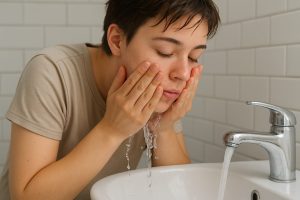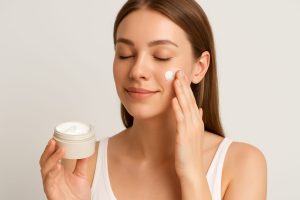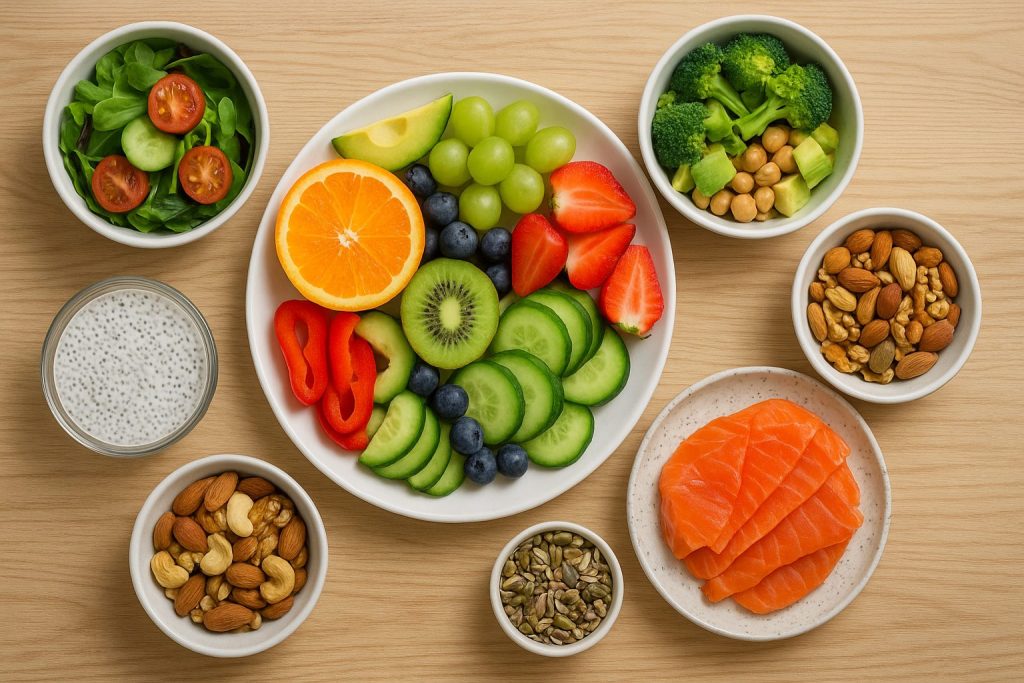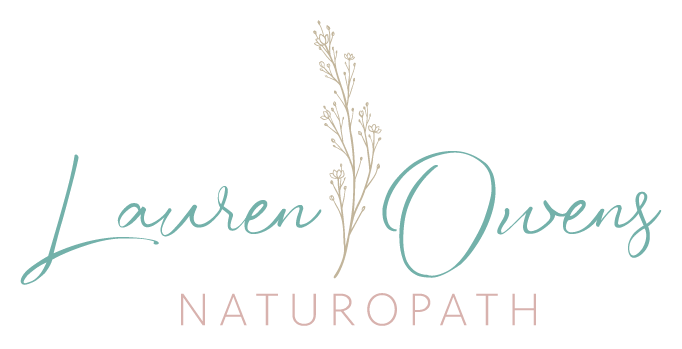When patients come to see me for acne, I often feel a deep connection because I’ve been there too. I vividly remember my own acne journey during my teens and into my 20’s: the lack of self-esteem, the embarrassment, and the distress of waking up each morning to find new sore spots.
Unless you’ve struggled with acne, it’s difficult to truly understand how deeply it can affect confidence and quality of life.
Looking back now, with the knowledge I’ve gained as a naturopath, I can clearly see how my own acne was influenced by gut issues and microflora imbalance, hormonal fluctuations, and poor dietary habits.
Around the time I became vegetarian at age 13, I also started experiencing chronic tonsillitis. I draw a link between the two events. I was likely low in iron, zinc, essential fatty acids and protein – all vital for skin repair and immune function. After years of having my tonsillitis treated with antibiotics, my gut microbiome was no doubt annihilated (nobody did microbiome tests back then), setting the stage for irritable bowel syndrome, signs of systemic inflammation and acne that persisted into my 20s.
Today, we know there’s a strong link between the gut, hormones, inflammation, and skin health. Acne rarely has a single cause. It’s usually the result of several interconnected imbalances. A perfect storm!

My Approach to Treating Acne
When treating acne naturally, I take a whole-body, root-cause approach. Every patient receives a detailed assessment that explores aspects such as:
- Digestive system function and gut microbiome health
- Hormonal health
- Immune system function
- Dietary quality and nutrient status
- Stress and sleep patterns
- Exercise and lifestyle habits
Depending on the case, I may recommend additional testing such as:
- Comprehensive gut microbiome mapping
- SIBO breath test
- Hormonal profile panel
- Full blood examinations through the patient’s GP
This detailed approach helps me uncover the underlying drivers of that patient’s acne to create a treatment plan that addresses the cause, not just the symptoms.
Understanding How Acne Develops (the pathophysiology)
To effectively treat acne, it’s important to understand the biological process behind it and the aspects that can drive and exacerbate it.
Acne develops through four key stages:
- Inflammatory response, marked by increased IL-6, TNF-alpha, and IL-1B
- Increased sebum production (oil secretion by sebaceous glands)
- Hyperkeratinisation of the hair follicle → formation of a keratin plug (comedone)
- Bacterial overgrowth, especially Cutibacterium acnes, which causes more inflammation so it can become a vicious cycle.
Common Underlying Drivers of Acne
- Hormonal changes (puberty, post-pregnancy, menopause)
- Hormonal dysregulation (e.g. PCOS)
- Post-oral contraceptive pill rebound effect
- Digestive system dysfunction and gut microflora imbalance
- Inflammatory, high-GI diets (ie. the typical western diet)
- Nutrient deficiencies (especially zinc, vitamin A, omega-3 fatty acids)
- Genetic predisposition (unfortunately some people are more prone)
Factors That May Worsen Acne
- Chronic stress and elevated cortisol
- Liver congestion and sluggish detoxification
- Lymphatic congestion
- Excessive intake of dairy foods
- Unsuitable skincare products that clog pores or damage the skin’s barrier
The Gut-Skin Axis: How Gut Health Affects Acne
The connection between the gut and the skin, known as the gut-skin axis, is one of the most important aspects of acne management.
A dysbiotic gut microbiome (imbalance between good and bad bacteria) can drive systemic inflammation that manifests in the skin.
Common Gut Test Findings in Acne Sufferers
These are some of the results I see in microbiome tests from my acne patients:
- Loss of beneficial short-chain fatty acid (SCFA)-producing bacteria
- Decreased Bifidobacterium species
- Increased Proteobacteria and Bacteroides
- Presence of Helicobacter pylori infection
- Elevated lipopolysaccharides (LPS) from pathogenic bacteria, triggering immune and skin inflammation
SIBO and Low Stomach Acid
Many acne patients have low stomach acid (hypochlorhydria), which allows bacteria to migrate into the small intestine, causing SIBO (small intestinal bacterial overgrowth).
SIBO damages the intestinal lining and leads to “leaky gut”, a condition where toxins and inflammatory compounds enter the bloodstream, worsening systemic inflammation and acne. It can also cause nutrient malabsorption, meaning your body struggles to absorb crucial skin nutrients like zinc, vitamin A, iron and essential fatty acids.

Hormones and Acne: Understanding the Connection
Hormonal imbalances are one of the most common drivers of acne, particularly in women. Hormones influence how much sebum your skin produces, how fast skin cells shed, and how easily pores become clogged.
Key Hormonal Influences
- Elevated Androgens (Testosterone, DHEA, DHT)
- These “male” hormones are present in both men and women and increase sebum (oil) production.
- During puberty, androgen levels surge, often triggering acne.
- In conditions like PCOS (Polycystic Ovary Syndrome), excess androgens contribute to persistent, cystic acne on the face, jawline, and back.
- Oestrogen and Progesterone imbalance
- Oestrogen helps balance oil production and inflammation.
- Low oestrogen (as seen after stopping the Pill or during perimenopause) can worsen acne.
- Progesterone, when balanced, helps calm inflammation and regulate skin cell turnover.
- Insulin and IGF-1 (Insulin-Like Growth Factor-1)
- High insulin and IGF-1 levels – which are triggered by sugar, refined carbs, and dairy – all contribute to elevated androgens and worsen acne.
- Cortisol (Stress Hormone)
- Chronic stress raises cortisol, which stimulates sebaceous glands and increases inflammation, leading to stress-related breakouts.
Post-Pill Acne
The oral contraceptive pill suppresses the hormones including androgen production. When you stop taking it, there’s often a rebound effect whereby testosterone levels temporarily spike and trigger increased sebum production leading to “post-pill acne.” To help reduce this effect, it is ideal to commence naturopathic treatment 2-3 months before stopping the oral contraceptive pill so that the body can be supported and prepared for the transition.
Diet and Acne
What you eat has a direct influence on your hormones, inflammation levels, gut health and eventually it can impact upon the appearance of the skin.
Refined carbohydrates and sugary foods cause insulin and IGF-1 spikes. These hormonal changes stimulate sebum production, increase keratin plug formation, and contribute to clogged pores – the perfect recipe for acne.
Dairy products naturally contain hormones and can raise IGF-1 levels, further aggravating acne in susceptible individuals.
The mTOR Pathway Explained
The mTOR (mechanistic target of rapamycin) pathway is a key cellular growth and metabolic regulator. It influences cell proliferation, protein synthesis, and sebum production.
- When mTOR activity is excessive – often due to a high-GI or dairy-rich diet – it drives:
- Increased sebaceous gland activity (more oil)
- Keratinocyte overgrowth (leading to clogged pores)
- Inflammatory signalling in the skin
- When mTOR activity is balanced, skin cell turnover remains healthy, and inflammation stays under control.
A low-GI, anti-inflammatory diet naturally helps downregulate overactive mTOR, leading to calmer, clearer skin.

My Naturopathic Treatment Approach for Acne
Because acne has many causes, there’s no one-size-fits-all plan. However, my treatment approach often includes:
1. Gut Health Support
- Increasing beneficial bacteria with fibre, prebiotics, and probiotics
- Optimising digestion to improve nutrient absorption
- Addressing SIBO or dysbiosis if appropriate (testing first)
2. Reducing Inflammation
- Implementing an anti-inflammatory, low-GI diet: opting for whole, unprocessed foods as much as possible and limiting packaged foods
- Eliminating or reducing dairy (at least whilst acne is still a problem)
- Introducing omega-3 fatty acids, antioxidants, and anti-inflammatory herbs – either through supplementation or diet or both.
3. Balancing Hormones
- Modulating hormones if unbalanced (such as androgen or oestrogen dominance) through herbs, diet and supplementation with natural compounds
- Supporting ovulation to naturally achieve a balance of oestrogen and progesterone
- Stabilising blood sugar through healthy dietary choices and lifestyle measures such as daily exercise
4. Stress and Emotional Support
- Nervous system support and use of herbal adaptogens if appropriate (Withania, Holy Basil and Rehmannia are some faves)
- Ensuring good sleep and stress management practices
- Supporting a healthy mood – through positive mindset practices and ensuring key nutrients for neurotransmitter synthesis are provided
5. Detoxification and Lymphatic Support
- Supporting liver detoxification with foods like broccoli, garlic, and beetroot
- Promoting lymphatic drainage through movement, hydration, and herbal support
- Ensure adequate dietary fibre intake to help excrete metabolised hormones and toxins naturally
- Avoidance of toxic personal care and household products; plastic bottles; non-stick cookware etc.
Treating acne naturally is a journey, not a quick fix. It requires understanding the root cause or causes for that person and treating accordingly.
Your skin is a reflection of your internal health. By addressing those key aspects such as your gut, hormones, diet, and stress, you can calm inflammation, rebalance body systems, and achieve healthy, glowing skin again. In the meantime, you will also be improving your overall health!
If you’re struggling with acne and want to explore a natural, root-cause approach, book a consultation to start your skin healing journey today.


